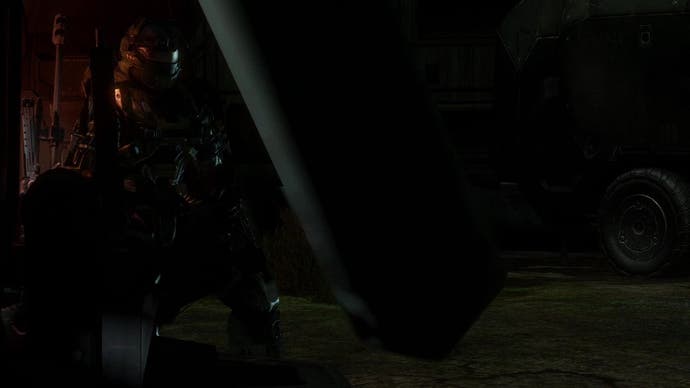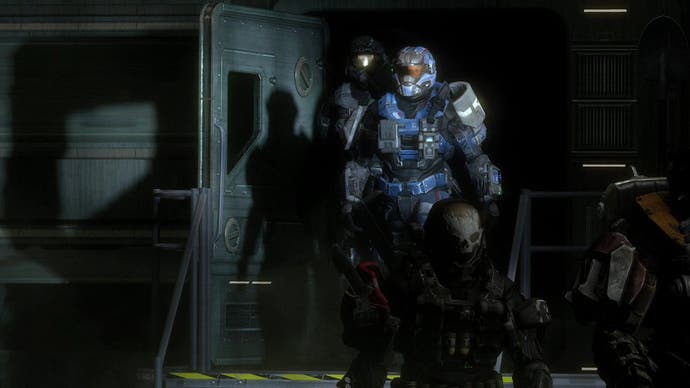Halo: Reach trailer analysis
Digital Foundry: Happy new MJOLNIR.
Aside from some blurry pre-alpha screenshots and unconfirmed game details, next to nothing has been revealed about Bungie's 2010 epic - Halo: Reach. Until now. Over the weekend, a new video was released, showcasing a massive technological leap over the previous Halo engine.
So, just how "real" is the new trailer? Prior to its unveiling, wording on the content was carefully chosen. The video would be "in-engine", the key phase missing there being "real-time". It's fairly obvious that what we have here is a offline render of a Reach cut-scene: Bungie effectively allowing the engine all the time it needs to create a massively high-resolution version of the cinematic, which is then downscaled to native 720p, eliminating all aliasing and producing a superb-looking presentation.
What we're seeing here is indeed in-game assets running in the new engine, it's just that we have no real idea how this will translate to actual run-time performance. More aliasing is an obvious given, but it's unclear what other tweakables within the engine Bungie ramped up in order to produce the best-looking trailer.
Back at E3 2006, two versions of the Halo 3 trailer made it out in the wild: a full-on super-sampled, 60FPS video, along with a run-time 30FPS rendition that exhibited plenty of aliasing. In that case, Bungie was sampling the code on the showfloor, so we'd be hugely surprised if a corresponding run-time version of this video were released.
What we do see in the trailer offers up plenty of cool discussion points though. Models, geometry and textures certainly look as though they are based on in-game assets, and in-game atmospherics and lighting are phenomenal. Material shaders in terms of the armour, vehicles and human faces are of an outstanding quality.
Indirect lighting (shown about a minute into the trailer) looks of a high quality and it's interesting to note that the shadows are of a high quality too. Coming out of the building, we see some low-resolution shadows, but the effect is decent owing to high-quality filtering. Human characters in terms of artwork and especially animation are hugely improved over the somewhat-average efforts in Halo 3 and ODST. Bungie also has a state-of-the-art motion capture studio in-house now that should help improve animation still further.


Over and above all of this, it is also worth remembering that the cinematics often show the engine running in a "best case" scenario. Certainly, in Halo 3, the cut-scenes often showed a higher graphical quality than the actual gameplay - the scene where the Arbiter stabs the Prophet of Truth showed a dramatic difference in lighting. How or whether this translates to Reach won't be apparent until we get to see proper in-game screenshots, which we don't expect until the beta launches some time in 2010.
With the tech stuff out of the way, does the Reach trailer give us any hints about how the new game fits into the established Halo canon? Obviously the fact that we get to see plenty of Spartan IIs in action is the big news here, but what is curious is that according to the existing mythos, there were only ever 75 of them, hand-picked from 150 children, hence John-117, the iconic Master Chief.
Spotted in the trailer were Jorge-052 (tank guy), Carter-259 (leader guy), Kat-320 (speedrunner with less armour from waist-level down). It'll be interesting to learn whether Bungie is adjusting the canon by introducing a new batch of Spartans we don't know about, or whether we are seeing the Spartan-IIIs here - cut-down, cannon-fodder troops lacking the refined genetics of the Spartan-IIs. As promised by Bungie, we also see the return of the ODSTs: the anonymous male's helmet was of the same design.
With the Halo Waypoint now established and a clear effort being made to build and reference an established timeline of events, it'll be intriguing to see how this plays out as more details on Halo: Reach emerge.
Thanks to Alex Goh for his input on this piece.

